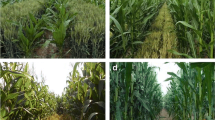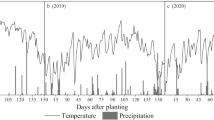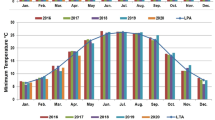Abstract
Food security has become a global issue, seriously threatening developing countries owing to fast-growing human populations and declining availability of land for agriculture. Increasing crop yields could be achieved by intensive systems, but these usually need higher energy and emit more carbon (C). Here, we studied crop productivity, energy yields, and C emissions of intercropping versus sole cropping. We tested maize–wheat, maize–rape, maize–pea, and soybean–wheat intercropping, and sole crops as controls in field experiments at Wuwei experimental station in from 2009 to 2011 in a randomized block design with three replicates. We used an evaluation index integrating yield and environmental factors. Results showed a yield increase of 27 % for maize–wheat, 41 % for maize–rape, and 42 % for maize–pea versus sole crops. Water use efficiency increased by 25 % for maize–wheat intercropping over sole wheat, 152 % for maize–rape over sole rape, and 95 % for maize–pea over sole pea. The three maize–crop intercrops produced 68, 308, and 256 % more energy yield than did the sole wheat, sole rape, and sole pea crops, respectively. They emitted 42, 52, and 45 % less C per unit of water in 2009, 2010, and 2011, respectively, compared with the sole maize crop. The maize-based intercropping received a the highest evaluation index (0.82 out of 1.0) among the systems evaluated, clearly showing that the maize-based intercropping is the most effective and sustainable cropping system for arid irrigation areas.


Similar content being viewed by others
References
Agegnehu G, Ghizaw A, Sinebo W (2008) Yield potential and land-use efficiency of wheat and faba bean mixed intercropping. Agron Sustain Dev 28:257–263. doi:10.1051/agro:2008012
Beedy TL, Snapp SS, Akinnifesi FK, Sileshi GW (2010) Impact of Gliricidia sepium intercropping on soil organic matter fractions in a maize-based cropping system. Agric Ecosyst Environ 138:139–146. doi:10.1016/j.agee.2010.04.008
Bessou C, Ferchaud F, Gabrielle B, Mary B (2011) Biofuels, greenhouse gases and climate change - A review. Agron Sustain Dev 31:1–79. doi:10.1051/agro/2009039
Blaser BC, Singer JW, Gibson LR (2007) Winter cereal, seeding rate, and intercrop seeding rate effect on red clover yield and quality. Agron J 99:723–729. doi:10.2134/agronj2006.0247
Blum A (2009) Effective use of water (EUW) and not water-use efficiency (WUE) is the target of crop yield improvement under drought stress. Field Crops Res 112:119–113. doi:10.1016/j.fcr.2009.03.009
Campbell CA, Selles F, Zentner RP, De Jong R, Lemke R, Hamel C (2006) Nitrate leaching in the semiarid prairie: Effect of cropping frequency, crop type, and fertilizer after 37 years. Can J Soil Sci 86:701–710
Chen F (2002) Agricultural Ecology. Press of China Agriculture University, Beijing, pp 261–263
Dyer L, Oelbermann M, Echarte L (2012) Soil carbon dioxide and nitrous oxide emissions during the growing season from temperate maize-soybean intercrops. J Plant Nutr Soil Sci 175:394–400. doi:10.1002/jpln.201100167
Fan ZL, Chai Q, Huang GB, Yu AZ, Huang P, Yang CH, Tao ZQ, Liu HL (2013) Yield and water consumption characteristics of wheat/maize intercropping with reduced tillage in an oasis region. Eur J Agron 45:52–58. doi:10.1016/j.eja.2012.10.010
FAO/UNESCO (1988) Soil map of the world: Revised legend. FAO, Rome
Fustec J, Lesuffleur F, Mahieu S, Cliquet JB (2010) Nitrogen rhizodeposition of legumes - A review. Agron Sustain Dev 30:57–66. doi:10.1051/agro/2009003
Gan YT, Campbell CA, Jansen HH, Lemke RL, Basnyat P, McDonald CL (2010) Nitrogen accumulation in plant tissues and roots and N mineralization under oilseeds, pulses, and spring wheat. Plant Soil 332:451–461
Gan YT, Liang C, Hamel C, Cutforth H, Wang H (2011a) Strategies for reducing the carbon footprint of field crops for semiarid areas - A Review. Agron Sustain Dev 31:643–656. doi:101007/s13593-011-0011-7
Gan YT, Liang C, Wang XY, McConkey BG (2011b) Lowering carbon footprint of durum wheat by diversifying cropping systems. Field Crops Res 122:199–206. doi:10.1016/j.fcr.2011.03.020
Gan YT, Liu LP, Cutforth H, Wang XY, Ford G (2011c) Vertical distribution profiles and temporal growth patterns of roots in selected oilseeds, pulses and spring wheat. Crop Pasture Sci 62:457–466. doi:10.1071/CP10406 1836-0947/11/060457
Gan YT, Siddique KHM, Turner NC, Li XG, Niu JY, Yang C, Liu LP (2013) Ridge–furrow mulching systems – an innovative technique for boosting crop productivity in semiarid rainfed environments. Adv Agron 118:429–476. doi:10.1016/B978-0-12-405942-9.00007-4
Gao Y, Duan AW, Sun JS, Li FS, Liu ZG, Liu H, Liu ZD (2009) Crop coefficient and water-use efficiency of winter wheat/spring maize strip intercropping. Field Crops Res 111:65–73. doi:10.1016/j.fcr.2008.10.007
Grassini P, Yang H, Irmak S, Thorburn J, Burr C, Cassman KG (2011) High-yield irrigated maize in the Western U.S. Corn Belt. II. Irrigation management and crop water productivity. Field Crops Res 120:133–141
Hastings A, Clifton-Brown J, Wattenbach M, Stampfl P, Mitchell PC, Smith P (2008) Potential of Miscanthus grasses to provide energy and hence reduce greenhouse gas emissions. Agron Sustain Dev 28:465–472. doi:10.1051/agro:2008030
Khan DF, Peoples MB, Schwenke GD, Felton WL, Chen D, Herridge DF (2003) Effects of below-ground nitrogen on N balances of field-grown fababean, chickpea, and barley. Aust J Agric Res 54:333–340
Kim S, Dale BE (2005) Life cycle assessment of various cropping systems utilized for producing biofuels: bioethanol and biodiesel. Biomass Bioenerg 29:426–439. doi:10.1016/j.biombioe.2005.06.004
Lemke RL, Zhong Z, Campbell CA, Zentner RP (2007) Can pulse crops play a role in mitigating greenhouse gases from North American agriculture? Agron J 99:1719–1725. doi:10.2134/agronj2006.0327s
Lithourgidis AS, Dhima KV, Vasilakoglou IB, Dordas CA, Yiakoulaki MD (2007) Sustainable production of barley and wheat by intercropping common vetch. Agron Sustain Dev 27:95–99. doi:10.1051/agro:2006033
Lorenz AJ, Gustafson TJ, Coors JG, Leon N (2010) Breeding maize for a bioeconomy: A literature survey examining harvest index and stover yield and their relationship to grain yield. Crop Sci 50:1–12. doi:10.2135/cropsci2009.02.0086
Luo YQ, Zhou XH (2006) Soil respiration and the environment. Academic Press, Burlington, pp 216–247
Nieder R, Benbi DK (2008) Carbon and nitrogen in the terrestrial environment. Springer, Heidelberg and New York, pp 430–442
Oelhermann M, Echarte L, Vachon K, Dubois C (2009) The role of complex agroecosystems in sequestering carbon and mitigating global warming. Earth Environ Sci 6:20–31. doi:10.1088/1755-1307/6/24/242031
Parkin TB, Kaspar TC, Senwo Z, Prueger JH, Hatfield JL (2005) Relationship of soil respiration to crop and landscape in the Walnut Creek Watershed. J Hydrometeor 6:812–824. doi:10.1175/JHM459.1
Qin AZ, Huang GB, Chai Q, Yu AZ, Huang P (2013) Grain yield and soil respiratory response to intercropping systems on arid land. Field Crops Res 144:1–10. doi:10.1016/j.fcr.2012.12.005
Shi PL, Zhang XZ, Zhong ZM, Ouyang H (2006) Diurnal and seasonal variability of soil CO2 efflux in a crop land ecosystem on the Tibetan Plateau. Agr Forest Meteorol 137:220–233. doi:10.1016/j.agrformet.2006.02.008
Sullivan P (1998) Intercropping principles and production practices: Appropriate technology transfer for rural areas. Fayetteville, AR, pp 56–71
Tilman D, Cassman KG, Matson PA, Naylor R, Polasky S (2002) Agricultural sustainability and intensive production practices. Nature 418:671–677
Yang JY, Drury CF, Yang XM, De Jong R, Huffman EC, Campbell CA, Kirkwood V (2010) Estimating biological N2 fixation in Canadian agricultural land using legume yields. Agric Ecosyst Environ 137:192–20
Zhai LM, Liu HB, Zhang JZ, Huang J, Wang BR (2011) Long-term application of organic manure and mineral fertilizer on N2O and CO2 emissions in a red soil from cultivated maize-wheat rotation in China. J Integr Agr 10:1748–1757. doi:10.1016/S1671-2927(11)60174-0
Zhang JL (2007) Barriers to water markets in the Heihe River basin in northwest China. Agric Water Manag 87:32–40. doi:10.1016/j.agwat.2006.05.020
Zhang FS, Li L (2003) Using competitive and facilitative interactions in intercropping systems enhances crop productivity and nutrient use efficiency. Plant Soil 248:305–312. doi:10.1023/A:1022352229863
Acknowledgments
This study was supported by the National Key Technology R&D Program of China (2012BAD14B10), the National Natural Science Fund (31160265), and the Special Fund for Agro- Scientific Research in the Public Interest (201103001). The authors also appreciate the assistance of the staff at Wuwei experimental station in managing field plots.
Author information
Authors and Affiliations
Corresponding author
Additional information
Qiang Chai & Anzhen Qin both authors contributed equally to the study.
About this article
Cite this article
Chai, Q., Qin, A., Gan, Y. et al. Higher yield and lower carbon emission by intercropping maize with rape, pea, and wheat in arid irrigation areas. Agron. Sustain. Dev. 34, 535–543 (2014). https://doi.org/10.1007/s13593-013-0161-x
Accepted:
Published:
Issue Date:
DOI: https://doi.org/10.1007/s13593-013-0161-x




